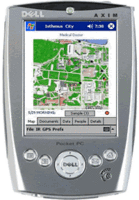Scaffolding + Scientific Reasoning in PDA/AR Games
After looking over Ming-Fong's list of observations related to the recent tests of Env Det and reflecting on our related discussion on Wednesday I think that it would be beneficial to start a reading category related to scaffolding (artifact, curricular, and human-based scaffolding) and another related to scientific reasoning. These topics may not take priority at the moment, but we have identified them through our discussions as critical components of the PDA/AR design.
Here are a few articles that can provide a starting point. Please post additional suggestions. The first two relate to scaffolding and the third one deals with developing and defending scientific arguments.
Here are a few articles that can provide a starting point. Please post additional suggestions. The first two relate to scaffolding and the third one deals with developing and defending scientific arguments.
Puntambekar, S., & Hübscher, R. (2005). Tools for Scaffolding Students in a Complex Learning Environment: What Have We Gained and What Have We Missed? Educational Psychologist, 40(1), 1-12.Presents a set of characteristics that define scaffolding and provides background on the use of tools to scaffold student learning. Could be used as a framework for exploring how PDA/AR games and associated curricula could better incorporate scaffolding. http://idcc.bentley.edu/~roland/articles/EP_puntambekar_hubscher_2005.pdf
Sherin, B., Reiser, B., & Edelson, D. (2004). Scaffolding analysis: Extending the scaffolding metaphor to learning artifacts. Journal of the Learning Sciences: 13(3), 387-421.Provides a brief genealogy of scaffolding (pgs. 387-398) and presents a framework for analyzing artifact-based scaffolding (pgs. 398-421). Scan part one and skip part two if you have limited interest in this topic.http://lore.sesp.northwestern.edu/publications/6414423109cc5e326.pdf
Kuhn, L & Reiser, B. (2004). Supporting Evidence-Based Scientific Explanation. Prepared for NARST 2004, Dallas, TX.Provides a framework that can be used to teach students how to construct and defend scientific evidence. Offers a starting point for someone looking to address the the problem related to kids supporting “their arguments with imagination.”http://www.sciencematerialscenter.org/papers/Students_Evidence_Based_Scientific_Explanations.pdf

1 Comments:
Probably because of my space fetish, I only scanned, and didn't get much of the SHERIN, REISER, EDELSON article on scaffolding -- except to note that for all the talk about designing "learning environments" precious little is mentioned about the physical spatial aspects of it ;-)
In the KUHN, REISER article, I was pleasantly reminded of the Claim, Evidence, Reasoning protocol. But the context section offers a "suburban middle school, outside of a large Midwestern
city" and "same suburb" and "grade 7–12 school in a large Midwestern city." Is this all the space/place context that matters? For all the space/place references in the content (Great Lakes, Galapogos, etc.) there's not much about the physical space students base their assumptions upon.
I haven't read the third one yet, and apologize for viewing them from a Space/Place perspective, but I seem to be slightly obsessed with it...
Post a Comment
<< Home